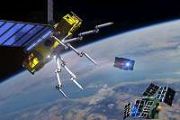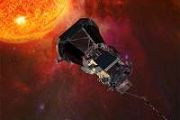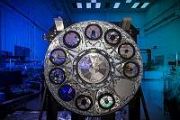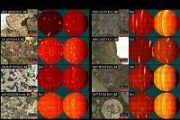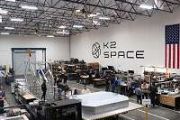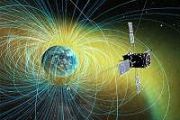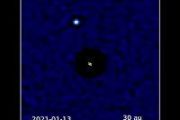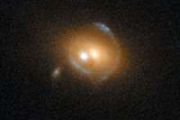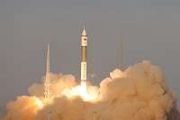
Copernical Team
Watch live: Workshop on Machine Learning for Earth System Observation and Prediction

Watch live
ESA-ECMWF workshop on machine learning for Earth system observation and prediction
Starfish Space and D-Orbit successfully conduct satellite rendezvous
 In a significant development in space logistics, Starfish Space and D-Orbit have successfully completed an on-orbit rendezvous between Starfish's Otter Pup and D-Orbit's ION SCV006 satellite. The coordinated effort involved precise maneuvering by the ION satellite, culminating in a close approach where Otter Pup captured detailed images of the ION spacecraft.
The mission began with recover
In a significant development in space logistics, Starfish Space and D-Orbit have successfully completed an on-orbit rendezvous between Starfish's Otter Pup and D-Orbit's ION SCV006 satellite. The coordinated effort involved precise maneuvering by the ION satellite, culminating in a close approach where Otter Pup captured detailed images of the ION spacecraft.
The mission began with recover South Australian space companies embark on growth mission with new UniSA program
 The University of South Australia (UniSA) has launched a new business growth program aimed at assisting early-stage space companies in South Australia. The program includes a six-month initiative called the Growth Ramp space pathway, hosting its first cohort of six companies.
The participating companies-AICRAFT, ESpy Ocean, HEX20, Orbital Blue, ResearchSat, and Robinson Aerospace Systems-a
The University of South Australia (UniSA) has launched a new business growth program aimed at assisting early-stage space companies in South Australia. The program includes a six-month initiative called the Growth Ramp space pathway, hosting its first cohort of six companies.
The participating companies-AICRAFT, ESpy Ocean, HEX20, Orbital Blue, ResearchSat, and Robinson Aerospace Systems-a Ovzon introduces two new satellite communication services based on Ovzon 3 technology
 Ovzon has unveiled two new satellite communication services, designed to enhance performance, mobility, and resilience for its users. The services, dubbed Ovzon Pegasus and Ovzon Orion, leverage the advanced capabilities of the newly launched Ovzon 3 satellite and its onboard processing technology.
The Ovzon Pegasus service utilizes a steerable beam technology enabled by the Ovzon 3 satell
Ovzon has unveiled two new satellite communication services, designed to enhance performance, mobility, and resilience for its users. The services, dubbed Ovzon Pegasus and Ovzon Orion, leverage the advanced capabilities of the newly launched Ovzon 3 satellite and its onboard processing technology.
The Ovzon Pegasus service utilizes a steerable beam technology enabled by the Ovzon 3 satell HKU Geologists reveal diverse volcanism in Lunar Apollo Basin, Chang'e-6 landing site
 The farside of the Moon has long been a subject of intrigue, particularly because it remains hidden from view on Earth. The most notable aspect of the Moon is the distinct difference in composition, crust thickness, and volcanic activity between the nearside and farside. The origin of these asymmetries remains unresolved, primarily due to a lack of samples from the farside, representing a major
The farside of the Moon has long been a subject of intrigue, particularly because it remains hidden from view on Earth. The most notable aspect of the Moon is the distinct difference in composition, crust thickness, and volcanic activity between the nearside and farside. The origin of these asymmetries remains unresolved, primarily due to a lack of samples from the farside, representing a major SSC partners with Perigee Aerospace for satellite launches from Esrange
 SSC has teamed up with South Korean company Perigee Aerospace Inc. to initiate satellite launches from Esrange Space Center in Sweden beginning in 2025. This partnership marks the first time an orbital rocket, Perigee's Blue Whale 1 microlauncher, will be launched from Esrange.
"I'm very pleased to announce this historic collaboration, our first orbital launch partnership. The market deman
SSC has teamed up with South Korean company Perigee Aerospace Inc. to initiate satellite launches from Esrange Space Center in Sweden beginning in 2025. This partnership marks the first time an orbital rocket, Perigee's Blue Whale 1 microlauncher, will be launched from Esrange.
"I'm very pleased to announce this historic collaboration, our first orbital launch partnership. The market deman Boeing Starliner crewed mission postponed to May 17
 The first crewed launch of Boeing's Starliner spaceship to the International Space Station has been pushed to May 17 after engineers said a faulty rocket valve needs to be replaced for the high-stakes mission, NASA said Tuesday.
The test has already faced years of delays and comes at a challenging time for Boeing, as a safety crisis engulfs the century-old aerospace titan's commercial aviati
The first crewed launch of Boeing's Starliner spaceship to the International Space Station has been pushed to May 17 after engineers said a faulty rocket valve needs to be replaced for the high-stakes mission, NASA said Tuesday.
The test has already faced years of delays and comes at a challenging time for Boeing, as a safety crisis engulfs the century-old aerospace titan's commercial aviati Long March 6C rocket joins fleet with successful inaugural launch
 China's Long March 6C rocket successfully completed its first flight on Tuesday, deploying four satellites into orbit.
Launching at 11:21 am from the Taiyuan Satellite Launch Center located in a mountainous area of Shanxi province, the 43-meter-tall rocket successfully placed a radar satellite, an optical remote-sensing satellite, and two experimental satellites into their designated orbit
China's Long March 6C rocket successfully completed its first flight on Tuesday, deploying four satellites into orbit.
Launching at 11:21 am from the Taiyuan Satellite Launch Center located in a mountainous area of Shanxi province, the 43-meter-tall rocket successfully placed a radar satellite, an optical remote-sensing satellite, and two experimental satellites into their designated orbit How NASA's Roman mission will hunt for primordial black holes

Video: Using a hopping robot for asteroid exploration
Use this form if you have come across a typo, inaccuracy or would like to send an edit request for the content on this page. For general inquiries, please use our contact form. For general feedback, use the public comments section below (please adhere to guidelines).
Please select the most appropriate category to facilitate processing of your request















